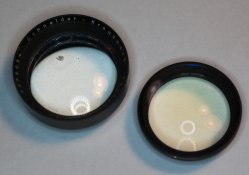Dan Daniel
Subscriber
Anyone ever heard of early Schneider Xenotars used in Rolleflexes having radioactive glass in them? I was taking apart a 2.8C. After I removed the rear group, I noticed that it was tinted yellow. I cleaned the lens group, and the color is still there-

This is a first series C, camera serial # 1255xxx. The lens is serial #3276054.
I have a couple of other C, the later 144+ serial number run. I looked through both of them (full lenses, installed in cameras) and noticed that they also have a yellow tint.
Any ideas? Glass? Or coatings? Any info? Thanks.

This is a first series C, camera serial # 1255xxx. The lens is serial #3276054.
I have a couple of other C, the later 144+ serial number run. I looked through both of them (full lenses, installed in cameras) and noticed that they also have a yellow tint.
Any ideas? Glass? Or coatings? Any info? Thanks.












